A Day in the Life of Lightroom
In the new version of Lightroom, Adobe developers have taken all of Lightroom 2's best features and either kept them or improved them. Then the found Lightroom 2's few weaknesses and banished them. The result is probably a photographer's best friend: Lightroom 3 is an application that is not only powerful but also easy to use. It's an outstanding workflow organizer, and it also prevents photographers from committing errors that could damage or destroy their images.
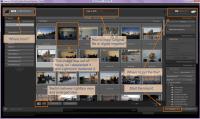 Let's start the day by importing some images. Lightroom 3 makes importing photographs a lot clearer and easier than it was in Lightroom 2.
Let's start the day by importing some images. Lightroom 3 makes importing photographs a lot clearer and easier than it was in Lightroom 2.
Don't move images outside of Lightroom. You can relink easily enough, but it's better not to create the problem for yourself by following Lightroom's 3-step workflow: Where are the images, how do you want to bring them into Lightroom, and where do you want to put them.
If you allowed Lightroom to set things up automatically, it will launch whenever you plug in a digital camera or a memory card, as I have done here. So step 1 is already taken care of.
The second step is deciding how you want to import the images. I shoot in raw mode, so I have a choice of importing the raw images or converting them to Adobe's digital negative (DNG) format. Both formats contain the same amount of information and there are good reasons for choosing both formats. If the files you're adding to Lightroom also exist on a hard drive, you'll have the additional options of moving or copying. Step 2 is done.
Step 3 is a bit more complex because there are several sub-steps. You can just specify a directory, but you may also want to import a second copy to another location or rename the files, apply some specific development settings, add keywords, or modify the image's metadata during import. You can, of course, just select the import directory and start the process.
Now that your images are in Lightroom, there's one important thing to remember: Don't move the images using the Windows Explorer or the Mac Finder because Lightroom can't track changes that it doesn't make. If you create this problem for yourself, it's easy enough to re-link the files as long as you remember where you put them; but it's even easier not to move files outside of Lightroom.
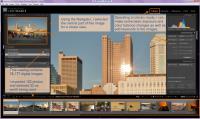 Library Mode is the next stop on the tour. This is where you'll make the first round of edits. The secret to being known as a good photographer is knowing what to discard. As you can see in the lower left corer, I downloaded 103 images from the camera. After the first cut, I had narrowed the likely suspects down to 32.
Library Mode is the next stop on the tour. This is where you'll make the first round of edits. The secret to being known as a good photographer is knowing what to discard. As you can see in the lower left corer, I downloaded 103 images from the camera. After the first cut, I had narrowed the likely suspects down to 32.
In the upper left corner, note how the Navigator panel can be used to zoom in on any part of an image; this area is then shown in the large display window. You may also note that the sharpness of the telephoto lens I was using for this image leaves quite a bit to be desired. I'll show you later how Lightroom can help make up for the faults of a substandard lens.
You can use the Quick Develop tools to make some overall changes to the white balance (temperature and tint), tone (exposure, clarity, and vibrance), keywords, and metadata. Changes made here can be applied to more than one image at a time, unlike the Develop Mode, which concentrates on one image at a time.
When you return from an event, you'll probably find that a lot of images were taken under similar circumstances: A group exposed outside in mid day sunlight, a group exposed in late afternoon light, some inside at night with a flash. Selecting all of the images from each group and pre-processing them by applying some basic modifications will save time later.
Developmental Editing
The next stop for the Lightroom bus is Develop Mode. This is where you have the greatest amount of control over images and, despite all the power tools lying around, there's no danger of harming even a single pixel of any image. The changes you make essentially record a list of instructions for how Lightroom displays and exports the image, so you can always get back to your original, unmodified image.
Most people, when they're working with photographs make one of two mistakes:
- They modify the original by cropping it, changing the color, applying effects, converting it to black and white, enlarging it, or reducing it and, when they realize that they still need the uncropped image, without effects, in color, at the original size, they're out of luck. That image is gone.
- They make copy after copy of the image as they apply different effects to it and then their hard drive is cluttered with dozens of copies (really, I've seen this happen!) of the same image.
Lightroom eliminates both of those problems because you can always revert the image to its original size, shape, and color. And if you need multiple copies of an image, you can create a virtual copy: There's still just one file on the disk, but Lightroom keeps two (or more) description files for modifications.
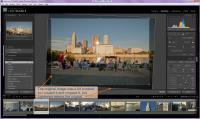 I'll walk you through modifying an image. The image shown here is the result of modifying an image that was dark, too contrasty, and crooked. All of the corrections have been made to the image, but here you can see that the original was rather crooked. Even though I've rotated it, lightened it, modified the color, and made other changes, the original is still there.
I'll walk you through modifying an image. The image shown here is the result of modifying an image that was dark, too contrasty, and crooked. All of the corrections have been made to the image, but here you can see that the original was rather crooked. Even though I've rotated it, lightened it, modified the color, and made other changes, the original is still there.
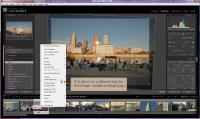 To see the original image again, while keeping my changes, I create a virtual copy and then reset the image to return it to its original state.
To see the original image again, while keeping my changes, I create a virtual copy and then reset the image to return it to its original state.
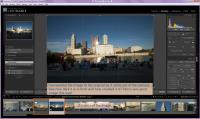 See! I told you it was too dark and that it was crooked. There's not much to recommend this image, but maybe I can save it.
See! I told you it was too dark and that it was crooked. There's not much to recommend this image, but maybe I can save it.
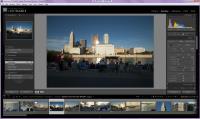 So now I've rotated it. There's still a slight keystone effect and, if you look closely you'll see that the buildings still lean a bit. The Leveque Tower (the tall building on the left) appears nearly straight and the State Office Tower (gray building in back) is good. Overall, it's acceptable, but still far too dark in the foreground. And because this is a late afternoon image, the color should be more rose colored.
So now I've rotated it. There's still a slight keystone effect and, if you look closely you'll see that the buildings still lean a bit. The Leveque Tower (the tall building on the left) appears nearly straight and the State Office Tower (gray building in back) is good. Overall, it's acceptable, but still far too dark in the foreground. And because this is a late afternoon image, the color should be more rose colored.
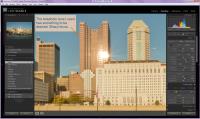 I used the temperature and tint controls to fix the color of the light, then added some fill light to open the shadows in the foreground. That washed out the colors, so I increased the black level a bit and pushed the vibrance to make the colors pop. These are the most used controls and that's why Adobe placed them at the top of the stack.
I used the temperature and tint controls to fix the color of the light, then added some fill light to open the shadows in the foreground. That washed out the colors, so I increased the black level a bit and pushed the vibrance to make the colors pop. These are the most used controls and that's why Adobe placed them at the top of the stack.
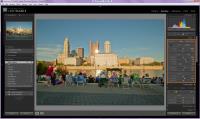 Now it's time to address the problems created by the marginal telephoto lens on the camera. Notice how mushy the edges of the buildings are. Ugh! I knew I should have bought a better lens.
Now it's time to address the problems created by the marginal telephoto lens on the camera. Notice how mushy the edges of the buildings are. Ugh! I knew I should have bought a better lens.
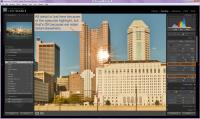 I pushed the clarity setting almost to the max and now there's some definition around the State Office Building's windows. That's the white building in the center of the image.
I pushed the clarity setting almost to the max and now there's some definition around the State Office Building's windows. That's the white building in the center of the image.
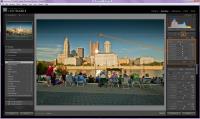 Then I thought it might be a good idea to use a graduated neutral-density filter on the sky. This darkens the sky quite a bit at the top and the effect is reduced as it approaches the skyline.
Then I thought it might be a good idea to use a graduated neutral-density filter on the sky. This darkens the sky quite a bit at the top and the effect is reduced as it approaches the skyline.
After creating yet another virtual copy, I have 3 images (the original, my first set of modifications, and the changes you've just seen) but still only one photo on the hard drive. But I can output those as 3 discrete images to share. Here they are:
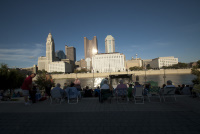 #1: The foreground of the original image was clearly too dark. This was the result of the camera's sensor reading the specular highlight from the sun and adjusting the image accordingly. It's also crooked.
#1: The foreground of the original image was clearly too dark. This was the result of the camera's sensor reading the specular highlight from the sun and adjusting the image accordingly. It's also crooked.
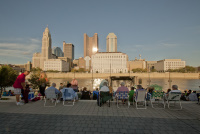 #2: This time we have detail in the foreground and the buildings are more or less straight. The color of the light is more accurate for late afternoon ("the golden hour") and overall it's a much better image than #1.
#2: This time we have detail in the foreground and the buildings are more or less straight. The color of the light is more accurate for late afternoon ("the golden hour") and overall it's a much better image than #1.
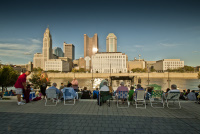 #3: This is another interpretation of the same image. It's somewhat more golden, the clarity has been boosted, contrast is a bit higher, and there's a neutral-density filter effect to darken the top edge of the sky.
#3: This is another interpretation of the same image. It's somewhat more golden, the clarity has been boosted, contrast is a bit higher, and there's a neutral-density filter effect to darken the top edge of the sky.
Accomplishing this in a darkroom could easily require a series of test prints and several hours of effort. With Lightroom, I accomplished the task in less than 10 minutes.
Say Goodbye to Noise
Despite all its advantages, digital photography has one serious annoyance: Noise. Two types of noise exist: luminance noise (white speckles) and color noise (apparently random colors). Higher ISO (speed) settings have more noise. Lightroom 2 was able to tame some of the noise, but Lightroom 3 improves noise reduction by what appears to be an entire order of magnitude. I'll explain.
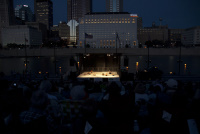 Let's start with this image from Waterfire. I needed a moderately high shutter speed for two reasons: I was not using a tripod and the dancers were moving. By setting the ISO to 400, I could get a shutter speed of 1/50th of a second, exposing for the light on the stage. I knew that I'd need to manipulate the image later because the image you see here is nothing to brag about.
Let's start with this image from Waterfire. I needed a moderately high shutter speed for two reasons: I was not using a tripod and the dancers were moving. By setting the ISO to 400, I could get a shutter speed of 1/50th of a second, exposing for the light on the stage. I knew that I'd need to manipulate the image later because the image you see here is nothing to brag about.
The people in the foreground are visible, not just shadows. The sky has some color. The buildings across the river, and the river itself, all have texture. The fire on the water is visible.
But I've also tamed the noise. Or, more accurately, Lightroom has tamed the noise.
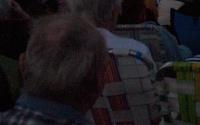 The process is nearly automatic. Lightroom offers sliders for luminance noise and color noise. The primary challenge to correcting either kind of noise is that the image tends to become mushy (that's a technical term for "fuzzy") as a result of the manipulation, but Lightroom 3 virtually eliminates that. At the right you'll see a small section from the lower left section of the image. Click the link to see the full-size view. The luminance noise would render any print made from the file mottled.
The process is nearly automatic. Lightroom offers sliders for luminance noise and color noise. The primary challenge to correcting either kind of noise is that the image tends to become mushy (that's a technical term for "fuzzy") as a result of the manipulation, but Lightroom 3 virtually eliminates that. At the right you'll see a small section from the lower left section of the image. Click the link to see the full-size view. The luminance noise would render any print made from the file mottled.
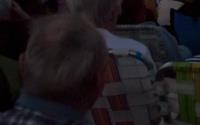 Now let's see what happens when I engage the noise reduction features from Lightroom 3. The difference is little short of astonishing.
Now let's see what happens when I engage the noise reduction features from Lightroom 3. The difference is little short of astonishing.
The additional clarity is evident in the final image (above).
Professional Photographers Don't ...
I'm always amused and disheartened (simultaneously) when I read a letter to the editor of a photography magazine that starts by claiming that professional photographers don't use (some new technology) because ....
It's silly.
- Professional photographers don't use auto-exposure. (1960s)
- Professional photographers don't use auto-focus. (1970s and 1980s)
- Professional photographers don't use digital cameras. (1990s)
- Professional photographers don't manipulate images with Photoshop. (Today)
Bullfeathers! as Colonel Potter used to say on MASH. (Or M*A*S*H, if you prefer.)
Professional photographers use whatever they can to produce the best possible image. I've actually read letters from self-described purists who feel that the only right way to use a digital camera is to record JPG images instead of raw images and to live with whatever you download from the camera. If you weren't good enough to obtain a perfect image, they reason, tough luck.
Would these "purists" insist that Ansel Adams never use push or pull processing, that he never dodge or burn an image in the darkroom? Would the bleach bypass processing technique be shunned? That's probably what this crowd would suggest.
I do not claim that I am as talented as Ansel Adams, but I do maintain that any photographer who's worthy of the name will use every means available to create the best possible images.
The Waterfire image I've shown here couldn't be captured on a film or digital camera without manipulation because the exposure difference between the lightest areas (on stage) and the darkest areas (in the crowd) present too much contrast to the film or the digital sensor. The only way to obtain detail in the light areas and the dark areas is by means of manipulation in the darkroom (or in Lightroom) after the fact.
And for that I make no apologies.
 Bottom Line: Lightroom 3 may not be perfect, but I can't think of anything to complain about.
Bottom Line: Lightroom 3 may not be perfect, but I can't think of anything to complain about.
I can't even begin to imagine thinking about digital photography without Lightroom. Applications such as this make me wish that I had a rating scale that ended at 10 or 100 or 1000 because Lightroom would earn the highest possible rating regardless of the top number. Serious amateurs will be delighted but professional photographers will immediately realize that Lightroom 3 is what they've been wishing for.
For more information, visit the Adobe Lightroom 3 website.
Thirty Books in My Briefcase
Well, I did it. I now own a Kindle. Despite the shortcomings when it comes to loading library books on the Kindle, I finally had to admit to myself that this is currently the best option for what I want to do with the device. So I've been using it for about half a month and I like what I've been able to do.
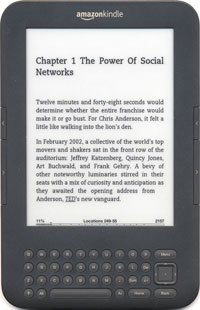 If you click the image for a larger view (depending on the size and resolution of your computer's screen) you might have about a life-size view of the Kindle. It measures just a little less than 5 inches across and 7.5 inches top to bottom. The screen is about 3.5 by 4.75 inches (the size of a small paperback book). It is thinner than most books, too, and it's certainly a lot lighter than War and Peace, which is loaded there. It's also considerably lighter than most books that deal with computer programs.
If you click the image for a larger view (depending on the size and resolution of your computer's screen) you might have about a life-size view of the Kindle. It measures just a little less than 5 inches across and 7.5 inches top to bottom. The screen is about 3.5 by 4.75 inches (the size of a small paperback book). It is thinner than most books, too, and it's certainly a lot lighter than War and Peace, which is loaded there. It's also considerably lighter than most books that deal with computer programs.
I've purchased a few technology-related books dealing with, for example: HTML5, CSS3, PHP, and such. But I've also downloaded a number of free publications such as Sir Arthur Conan Doyle's Sherlock Holmes stories. I've already read these stories, but I couldn't resist the opportunity to read them again.
Many of the procedures presented to allow loading library books on the Kindle attempt to break digital rights management (DRM). Although I consider DRM to be an abomination, I do honor it. So I haven't yet been able to find a way to place library books on the device.
It is shortsighted, silly, and typical of corporate policies for Amazon to make reading library books difficult on the Kindle.
Because the Kindle uses power only when changing pages or accessing Wi-Fi or cellular connections, recharging the battery is something you need do only occasionally. And because the device is designed to work much the way paper does:
- It's extremely easy to read in standard room light, outdoor, in direct sunshine, at the beach, or anywhere you'd be able to read a newspaper or book, but
- It's impossible to read in a dark room.
I had hoped to be able to talk more about loading library books onto the Kindle for this report. The process, although not too difficult, requires a lot of steps. The process is described quite well on the Stream Recorder website. But it shouldn't be this hard.
 Bottom Line: I'd like to give the Kindle 5 cats, but there are too many disadvantages.
Bottom Line: I'd like to give the Kindle 5 cats, but there are too many disadvantages.
Amazon's corporate policies are the reason that I give the Kindle only 2 cats even though I like the way that it works. Amazon needs to understand that people don't want to be locked in to a single system. Allowing users to read library books on the device isn't an impossible task; it's simply something that Amazon has decided not to allow. So I love it. And I hate it.
Hello, Amazon: Do the right thing and I'll gladly rate the Kindle 5 out of 5.
For more information, visit the Amazon website.
Short Circuits
Do You Have a Kindle Yet?
The Harris polling company says that 10% of us already have an electronic book reader of some sort than that another 15% of us will buy one between now and March of next year. Remember when cell phones went from being something that only a dilettante would own to something that everybody needed? Readers seem to be on that track.
Reading used to be simple. You buy a book or borrow one from the library. You then read the book and put it on a shelf or return it to the library. Now you can download a book and read it. In fact, you can carry dozens (or hundreds) of books around with you.
Deja vu: I was amazed in the 1970s to be able to carry a cassette with an hour's worth of my favorite music around. Then came CDs. And DVDs. And devices that could hold tens of thousands of selections. The same thing is happening to books.
The Harris Poll surveyed just under 3000 online adults in early August and learned that 40% of us read 11 or more books a year. (WOW! There is hope for the nation after all!) About 20% of us read 21 or more books in a year. The highest numbers come from those who already own electronic readers.
More than 20% of the respondents said that they had not purchased any books in the past year compared to only 8% of electronic reader owners. About 12% of the respondents said that they had purchased more than 10 dead-trees books in the past year, but almost 20% of the owners of electronic readers had purchased 11 or more books and 12% had bought 21 or more books in the past year.
Publishers should be excited about this. Although e-books sell for far less than printed books, there's also no cost for printing or distribution.
The .Doc File of J. Alfred Prufrock
I don't remember whether it was in high school or college that I encountered "The Love Song of J. Alfred Prufrock" by T.S. Eliot. It's the only work by Eliot that I really liked (or understood). I mean, "The Waste Land" was just impossible unless you were able to read Latin (I could, a little, barely, maybe) and Greek (sorry, Charlie). But Prufrock was at least accessible because it was all in English.
Now a computer geek has written (parodied) an updated version called "The .Doc File Of J Alfred Prufrock (with deepest apologies to T.S. Eliot)": "This morning I was asked to change my password on my work computer, as I must do every four months. And I sat there waiting for it to authorise my new password, and I thought, I have measured out my life in login codes.
"And, as it so often does, then my brain screwed me out of several hours of productivity."
This is amazing, amusing, and fun. Enjoy!
THE .DOC FILE OF J ALFRED PRUFROCK
with deepest apologies to T.S. Eliot
Let us go then, you and I,
When the evening is spread out against the sky
Like a laptop, put in sleep mode on a table
Let us go through certain half-deserted streets
The blinking-light retreats
Of restless nights in free-wifi cafes
And public libraries with internet
Streets that follow like messageboard argument
of insidious intent
To lead you to an overwhelming blog post
Oh, do not ask, "What, yaoi?"
Let us go and post an entry.
In the room the players come and go
Talking of their scores on Halo.
The yellow fog that rubs its back upon the Windows PC
The yellow smoke that rubs its muzzle on the Macintosh
Licked its tongue into the corners of the evening
Lingered upon the trackpads in their case
Let fall upon its back the crumbs that fall to keyboards,
Slipped by the flashdrive, made a sudden leap
and seeing that it was a soft October night
Curled once about the mouse, and fell asleep.
And indeed there will be time
For the yellow smoke that slides along the desk,
Rubbing its back upon the Windows PC;
There will be time, there will be time
To prepare a face to meet the icons that you meet;
There will be time to murder and respawn
And time for all the Chrome and Firefox
That drag and drop a website on your plate;
Time for .doc and time for .ppt
And time yet for a hundred indecisions,
And for a hundred fanfics and revisions,
Before the taking of a toast and tea.
In the room the players come and go
Talking of their scores on Halo.
And indeed there will be time
To wonder, "Is this wanky?" "Is this fair?"
Time to turn back and descend the stair
With a comment on the level of your player
[They will say: "How his server's lagging slow!"]
My morning cosplay, collar mounting firmly to the chin
My website rich and modest, but accessed by a simple login
[They will say: "But how his content's growing thin!"]
Do I dare
Disturb the interwebs?
In a minute there is time
For fanfictions and revisions which Google Docs may reverse.
For I have known them all already, known them all:—
Have known the RPs, archives, messageboards
I have measured out my life with usernames.
I know the voices dying with a 404
Beneath the music from a farther room.
So how should I presume?
And I have known the mods already, known them all --
The eyes that fix you in a formulated phrase
And when I am banhammered, sprawling on a pin,
When I am banned and wriggling on the wall,
Then how should I begin
To spit out all the fragments of my browser cache?
And how should I presume?
And I have known the sites already, known them all —-
Sites that are Web two-oh, white and bare
[But on my cellphone, still given to fail!]
It is the javascript impress
That makes them so digress?
Sites that stretch out like a table, or word-wrap like a shawl
And should I then presume?
And how should I log in?
Shall I say, I have gone at dusk through archived files
And watched the dialup sequences that blink
No more from AOL in lonely Windows?
I should have been a line of ragged code,
Scuttling through the compiler, breaking apps.
And the messageboard, the website, sleeps so peacefully!
Smoothed by long fingers,
Asleep...tired...or it malingers
Returning 404, here in front of me.
Should I, after iPhone apps and prices,
Have the strength to force AT&T to crisis?
But though I have wept and emailed, wept and played,
Though I have seen my avatar brought in upon a platter,
I am no hacker -- and here's no great matter;
I have seen the screen of my laptop flicker,
And I have seen the eternal bluescreen hold my eye, and snicker,
And in short, I was afraid.
And would it have been worth it, after all,
After the games, social media, the blogs,
Among the twitters, among some talk of IRC logs,
Would it have been worth while
To have bitten off the fandom with a smile,
To have squeezed the internet into a ball
To roll it toward some ass on Yahoo Questions
To say, "I am Babbage, come from the dead,
Come back to ban you all, I shall ban you all" --
If one, sending a textmessage, autocorrected
Should say: "That is not what I typed at all.
That is not it. LOL."
And would it have been worth it, after all,
Would have been worth while
After the LOLcats and the macros and the youtube clips,
After the spambots, after the blog space, after LiveJournal trailing on the floor
-- And Digg, and so much more? --
It is impossible to type just what I mean!
But as if a new .avi threw the nerves in patterns on the screen:
Would it have been worth while
If one, texting or throwing back Red Bull,
And turning towards the PC, should say,
"That is not what I typed at all.
That is not it. OH LOL."
No! I am not Lovelace,
nor was meant to be,
Am on some messageboard, one that will do
To send things viral, start a meme or two,
Edit the wiki, no doubt an easy tool,
Deferential, glad to be of use,
Pwning, sometimes, but anonymous,
Filled with citations, all a bit obtuse;
These edits, indeed, almost ridiculous --
Can you not work Google?
I grow old... I grow old...
I shall add some links to my blog roll.
Shall I change my default pic? Do I dare to eat a peach?
I shall play some World of Warcraft, and walk upon the beach.
I have heard the servers singing, each to each.
I do not think that they will sing to me.
I have seen cats talking in capslock on the web,
All up in ur fridge, eatin' ur food
When my laptop lights the darkness white and black.
We have lingered in the tubes of internet,
By URLS wreathed with info, loaded-down
Till cellphones ringing wake us, and we drown.
Source: http://copperbadge.livejournal.com/3102544.html#cutid1

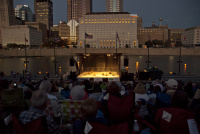

 The author's image: It's that photo over at the right. This explains why TechByter Worldwide was never on television, doesn't it?
The author's image: It's that photo over at the right. This explains why TechByter Worldwide was never on television, doesn't it?
